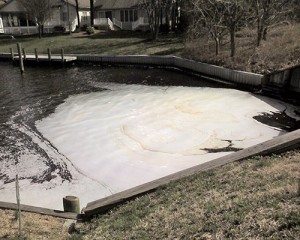
Kathy Phillips
Special To The Dispatch
These spring days set our minds to cleaning the yard, opening the pool and getting the boat ready for summer fishing season. Our coastal watershed is a summertime playground for boating, fishing, crabbing, clamming and swimming. Each of us needs to do our part to keep our waterways ‘swimmable and fishable.’ Remember what goes into the water today ends up in our fish and shellfish tomorrow.
Make yourself aware of Maryland’s Lawn Fertilizer Law which took effect Oct. 1, 2013. Lawn fertilizers are rich in nutrients and when you water your lawn, or it rains, these nutrients wash off into our canals and bays feeding those monsters of green slime and algae that clog your boat motor intakes and starve aquatic life. Don’t fertilize if rain is predicted. Keep a “no fertilizer zone” from canals and waterways of at least 15 feet. Use phosphorus free fertilizers and don’t apply more than 0.9 pound total nitrogen per 1,000 square feet. These rules are now mandated by Maryland law. To ease your pain, plant native shrubs, flowers and grasses, which don’t require fertilizer, along your bulkheads or along the edge of lawn that slopes to a roadside drainage ditch. Visit the Maryland Department of Agriculture website, http://mda.maryland.gov/Pages/fertilizer.aspx to learn more about the lawn fertilizer regulations.
With so many boats on the water, small discharges of oil, sewage and toxic maintenance products from our boats can add up. Give your boat a spring tune-up by a trained technician to make sure all fuel lines are tight and your engine is running at peak capacity.
If you’re going to clean your own boat at home be sure to read the label of your cleaning products carefully, especially if your boat is moored on the water when you clean. Avoid purchasing products labeled “hazardous,” “toxic,” or “flammable.” Chlorine bleach, when discharged into the water, instantly kills all nearby aquatic life including grasses, fish and crabs. Choose vegetable or citrus-based biodegradable soaps.
Try to have your boat out of the water and in a location where your used wash water will not run into nearby street drains, unless you only used plain water to clean your boat. The Department of Natural Resources advises when pressure washing paint, use the least amount of pressure necessary to remove the growth but leave the paint intact. Where practical, use a regular garden-type hose and a soft cloth. Visible solids must be removed from wash water before it may be discharged. Discharge treated wash water to surface water if no detergents or other chemical cleaning agents were used. If detergents were used, the wastewater must be directed into a sewer system (not a street drain). If your used wash water has detergents, chemicals or solids in it and has pooled up in your driveway, use a “wet vac” to vacuum it up and flush the dirty water through a sanitary sewer system.
Minimize the effects of cleaning your docks. Old piers and docks built from creosote treated pilings and pressure treated wood should never be power washed and is in violation of environmental laws. The force of the power washer will cause polluting toxins and chemicals to be released from the wood into the water. Good old fashioned elbow grease with a nylon scouring pad and some borax will get those stains out. Use water-based preservative stains on your docks and minimize the amount of the product splashed into the water below. Avoid using spray paint equipment.
When opening your swimming pool for the summer season, use a certified pool maintenance company. They acquire State permits and know they must remove all traces of chlorine and chemicals from the old pool water before it can be pumped out. Don’t be shy, ask your pool company to show you how they do it. If you’re a do-it-yourself person, use your test strips to make sure your old pool water has no traces of chlorine before you pump it out. Remember that chlorine instantly kills all aquatic life when it enters the water column. Once you know the old pool water is chemical free, let the hose slowly drain your pool to a vegetated area of your property so the water can slowly percolate into the ground, rather than pumping it directly into the bays.
The Clean Water Act makes it illegal to discharge any substances into our canals or bays without a special permit and prohibits dirty wash water or pool water discharges to our waterways. Refer to www.assateaguecoastkeeper.org where you can find a printable “Green Cleaning Guide For Your Boat” and a clean-green lawn guide.
(The writer is the Assateague COASTKEEPER as well as executive director for Assateague Coastal Trust.)
